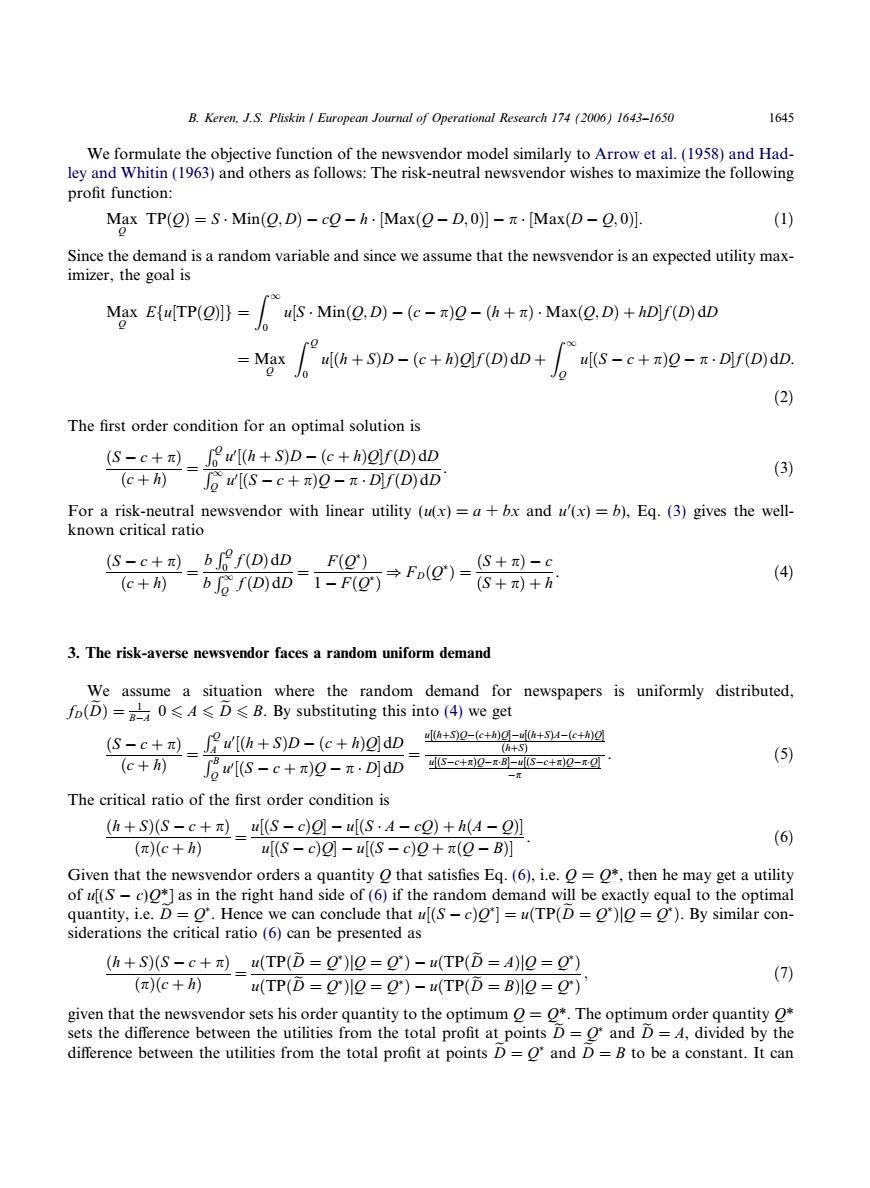正在加载图片...

B.Keren.J.S.Pliskin European Journal of Operational Research 174 (2006)1643-1650 1645 We formulate the objective function of the newsvendor model similarly to Arrow et al.(1958)and Had- ley and Whitin(1963)and others as follows:The risk-neutral newsvendor wishes to maximize the following profit function: Max TP(g)=S.Min(g,D)-cQ-h·[Max(2-D,0)]-元·[Max(D-2,0l. (1) Since the demand is a random variable and since we assume that the newsvendor is an expected utility max- imizer,the goal is Max Efu[TP()])= u[S.Min(g,D)-(c-元)g-(h+π)·Max(Q,D)+hDlf(D)dD Max Jo +D(D)dD. (2) The first order condition for an optimal solution is (S-c+)fu[(h+S)D-(c+h)olf(D)dD (c+)6WIS-c+π)0-π·Df(D)dD (3) For a risk-neutral newsvendor with linear utility (u(x)=a+bx and u'(x)=b),Eq.(3)gives the well- known critical ratio (S-c+n)bff(D)dD F(2) (c+)=b分fD)dD=1-F(g→F(0)=G+)+b: (4) 3.The risk-averse newsvendor faces a random uniform demand We assume a situation where the random demand for newspapers is uniformly distributed, fo(D)=a六0≤A≤D≤B.By substituting this into(4)we get S-c+为=2[h+S)D-(c+h)g]dD_+0-cwg+-ch☑ (h+S) c+h)o[(S-c+π0-π,D]dD S-c+0-R-S-c+0-☑ (5) 一 The critical ratio of the first order condition is h+SS-c+型_S-c)g-4S·A-cg)+h(4-1 (π(c+h) uS-c)g-uS-c)0+π(Q-B] (6) Given that the newsvendor orders a quantity O that satisfies Eq.(6),i.e.O=O*,then he may get a utility of ul(S-c)O*]as in the right hand side of(6)if the random demand will be exactly equal to the optimal quantity,i.e.D=O'.Hence we can conclude that u[(S-c)O]=u(TP(D=O")o=O).By similar con- siderations the critical ratio(6)can be presented as (h+S)(S-c+)u(TP(D=O)le=O)-u(TP(D=A)lO=O) (7) (π)(c+h) u(TP(D=g)I№=Q)-u(TP(D=B)=) given that the newsvendor sets his order quantity to the optimum O=O*.The optimum order quantity O* sets the difference between the utilities from the total profit at points D=O and D=4,divided by the difference between the utilities from the total profit at points D=O'and D=B to be a constant.It canWe formulate the objective function of the newsvendor model similarly to Arrow et al. (1958) and Hadley and Whitin (1963) and others as follows: The risk-neutral newsvendor wishes to maximize the following profit function: Max Q TPðQÞ ¼ S MinðQ; DÞ cQ h ½MaxðQ D; 0Þ p ½MaxðD Q; 0Þ. ð1Þ Since the demand is a random variable and since we assume that the newsvendor is an expected utility maximizer, the goal is Max Q Efu½TPðQÞg ¼ Z 1 0 u½S MinðQ; DÞðc pÞQ ðh þ pÞ MaxðQ; DÞ þ hDf ðDÞdD ¼ Max Q Z Q 0 u½ðh þ SÞD ðc þ hÞQf ðDÞdD þ Z 1 Q u½ðS c þ pÞQ p Df ðDÞdD. ð2Þ The first order condition for an optimal solution is ðS c þ pÞ ðc þ hÞ ¼ R Q 0 u0 ½ðh þ SÞD ðc þ hÞQf ðDÞdD R 1 Q u0 ½ðS c þ pÞQ p Df ðDÞdD . ð3Þ For a risk-neutral newsvendor with linear utility (u(x) = a + bx and u0 (x) = b), Eq. (3) gives the wellknown critical ratio ðS c þ pÞ ðc þ hÞ ¼ b R Q 0 f ðDÞdD b R 1 Q f ðDÞdD ¼ F ðQ Þ 1 F ðQ Þ ) F DðQ Þ ¼ ðS þ pÞ c ðS þ pÞ þ h . ð4Þ 3. The risk-averse newsvendor faces a random uniform demand We assume a situation where the random demand for newspapers is uniformly distributed, fDðDeÞ ¼ 1 BA 0 6 A 6 De 6 B. By substituting this into (4) we get ðS c þ pÞ ðc þ hÞ ¼ R Q A u0 ½ðh þ SÞD ðc þ hÞQdD R B Q u0 ½ðS c þ pÞQ p DdD ¼ u½ðhþSÞQðcþhÞQu½ðhþSÞAðcþhÞQ ðhþSÞ u½ðScþpÞQpBu½ðScþpÞQpQ p . ð5Þ The critical ratio of the first order condition is ðh þ SÞðS c þ pÞ ðpÞðc þ hÞ ¼ u½ðS cÞQ u½ðS A cQÞ þ hðA QÞ u½ðS cÞQ u½ðS cÞQ þ pðQ BÞ . ð6Þ Given that the newsvendor orders a quantity Q that satisfies Eq. (6), i.e. Q = Q*, then he may get a utility of u[(S c)Q*] as in the right hand side of (6) if the random demand will be exactly equal to the optimal quantity, i.e. De ¼ Q . Hence we can conclude that u½ðS cÞQ ¼ uðTPðDe ¼ Q ÞjQ ¼ Q Þ. By similar considerations the critical ratio (6) can be presented as ðh þ SÞðS c þ pÞ ðpÞðc þ hÞ ¼ uðTPðDe ¼ Q ÞjQ ¼ Q Þ uðTPðDe ¼ AÞjQ ¼ Q Þ uðTPðDe ¼ Q ÞjQ ¼ Q Þ uðTPðDe ¼ BÞjQ ¼ Q Þ ; ð7Þ given that the newsvendor sets his order quantity to the optimum Q = Q*. The optimum order quantity Q* sets the difference between the utilities from the total profit at points De ¼ Q and De ¼ A, divided by the difference between the utilities from the total profit at points De ¼ Q and De ¼ B to be a constant. It can B. Keren, J.S. Pliskin / European Journal of Operational Research 174 (2006) 1643–1650 1645���������������������������������������������������������